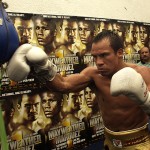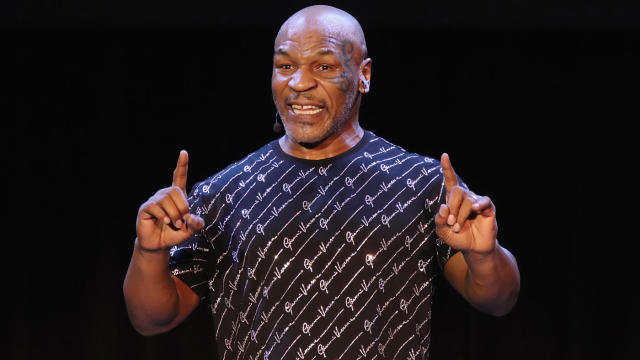
“How did you go bankrupt?” Bill asked. “Two ways,” Mike said. “Gradually and then suddenly.” – Ernest Hemingway, “The Sun Also Rises”
And so it is with a prizefighter’s energy and legs. He begins a championship fight doing as he planned. He loses strength at predictable intervals, familiar intervals, intervals commensurate with his opponent’s. Then suddenly he finds himself weak and discomfited.
So go championship prizefights. So go champions’ careers.
That race, right there, who gets from gradual bankruptcy to sudden first, will determine the loser of “The Rematch” at Mandalay Bay. That is what they’re calling the second fight between Ring magazine lightweight champion Juan Manuel Marquez and Juan Diaz, to remind us Marquez-Diaz I was 2009’s Fight of the Year.
Think of this fight as a race – Marquez’s legs against Diaz’s energy – where the loser will be lightweight champion of the world. The gradual bankruptcy of Marquez’s legs can be measured in years. The gradual bankruptcy of Diaz’s energy will be measured in minutes. And then, suddenly, one of those will be measured in instants.
Something like that happened when Marquez and Diaz fought the first time, in Diaz’s hometown of Houston, 17 months ago. Few of us knew it at the time, and no one knew it at ringside. The closest anyone came, probably, was Marquez’s trainer Nacho Beristain. He couldn’t be sure his fighter’s legs wouldn’t wilt under the heat and humidity of Diaz’s relentlessness, but he knew his fighter’s spirit was implacable and courage unquestionable. And he knew he wasn’t going to stop the fight regardless.
“Juan is not fragile.” That’s how Beristain explained it an hour after his fighter knocked-out Diaz in round 9. Beristain was certain to a point of dismissive about his charge’s fortitude in those opening rounds when Marquez’s mouthpiece was visible for two of every three minutes. He was amused by an inquiry about his own state of mind when Marquez was bullied to the ropes by the “Baby Bull” time and again. No, Beristain wanted it understood, he couldn’t have been less preoccupied by what he saw.
He was about the only one. Diaz appeared to have his way with Marquez in the fight’s opening half. He had me fooled; I scored the opening six rounds 4-1-1 for Diaz. And after round 6, when an esteemed fight scribe leaned over and said Marquez wouldn’t get out of the eighth, I nodded.
But by then Marquez had begun to do something we mistook for a ruined spirit. He’d begun to pivot away from Diaz rather than fighting Diaz off him. It was uncharacteristic of Marquez. He was the more accurate puncher in every minute, of course, but he was also the smaller and older man. His sudden change of strategy appeared, if not a surrender, certainly the opening sentence of an unfavorable treaty: You let me finish on my feet, and I’ll stay out of your way.
What had really happened, though, was different. Marquez had seen the first cracks in Diaz’s relentless spirit. Those cracks lent Marquez time enough to take a look around. And when he did, he realized he was not being outmaneuvered but cowed. Diaz was not pinning him to the ropes with superior footwork but merely corralling him with activity. And that reminded Marquez he hadn’t survived the rings of Mexico City without discouraging a few relentless left-hookers.
That was when the 35 year-old switched from brawler to dancer to assassin. He pivoted away from Diaz and struck the younger man now searching for an abruptly elusive target. He stopped trying to break Diaz on Diaz’s terms and began to stretch him on the rack of fundamental boxing: straight punches hurt more than crooked ones.
Diaz must have been surprised. He had, after all, faced larger, tougher men at lightweight, wearing each down with his knuckles, the cuffs of his gloves, the commitment of his blows, his self-belief. Here was a smaller man whose temples he’d assaulted with 20 minutes of hooks. Here was a lighter man whose neck he’d whiplashed with battering-ram jabs. Here was a boxer, a craftsman, whose sensibilities he’d surely offended.
And now he pivots away on fresh legs? And now my knees are suddenly hollow?
But Diaz did the right thing when bankruptcy visited him suddenly: He pressed forward. He was either about to fool Marquez, or bring a mercifully quick conclusion to his evening. And Marquez wasn’t fooled.
Marquez is hard to fool. Ask Floyd Mayweather. Mayweather apologists – a species the great man himself is rendering extinct – may still insist that after knocking Marquez down in the second round of their mismatched fight, Mayweather didn’t press because he “needed rounds.” But that’s inane. Rounds to do what, sharpen his potshots on a man 15 pounds smaller? Mayweather could get better work in the gym.
No, Mayweather didn’t press Marquez because, 15 pounds or 50, you don’t stop Marquez without making a slow tour of hell to get there. That’s not Mayweather’s style. Even when Marquez was hurt, especially when he was hurt, he fought back with harshest intentions. Mayweather was against the best counterpuncher he’d ever faced, and he backed off. Mayweather couldn’t stop Marquez in 100 rounds of trying.
Diaz, on the other hand, hasn’t Mayweather’s luxury of reflexes or class. He will have to go straight at Marquez because it affords him the best chance of making Marquez’s now-36-year-old legs go bankrupt. And in so doing, Diaz will afford Marquez a chance to take Diaz’s energy to bankruptcy, by pivoting away earlier and finishing Diaz quicker than the first time.
Marquez has been losing his legs gradually since he moved from featherweight. So is it possible they could go bankrupt suddenly on Saturday? Yes. Does Diaz have the style to cause it? Yes. Does Diaz have the energy to do it? I don’t think so.
I’ll take Marquez: KO-7.
Bart Barry can be reached at bbarry@15rounds.com









